One of the first thoughts I personally processed when I first saw these smaller than guppy sized trout, was “where is the sand, or fine gravel . . . and where is the current for the little guys (and gals).”
They were in little more than a Tupperware tub, with a coated screen to keep them off the bottom (and let crud through).
But, when one thinks about it, they are quite a miracle of life. The hatchery manager said they are the smallest fry he has ever seen. Indeed, upon first seeing them there was a bit of a shock as their tininess— the oh so very fragile state that they are in— began to sink in.
Many of these little gals and guys are little more than eyed out eggs. Many still have their yolk sac firmly attached, and are essentially drawing their life and nutrients from that first plasma they were conceived in.
Hopefully their development will follow a normal healthy path—hopefully some of these fry will grow up to ultimately fully develop into phenotypical Alvord cutthroat trout—that may be utilized for future propagation purposes and pave the way for future efforts to bring the appearance of the Alvord cutthroat trout back into vogue.
Sometimes it’s hard to believe that the substance to propagate a species could come in such tiny packages. But then DNA and it’s double helix strands with it’s encoded messages is far tinier than the human eye can see— and yet contains the blueprints and construction codes for the spotting patterns and coloration, for the pyloric caeca and gill rakers, for scale count and for fin rays— and for every other detail that differentiates one species from another.
May these trout develop the very characteristics; the very meristic and visible indicators, to distinguish them as remnants of an ancient extinct species that still has some of it’s DNA swimming in a tiny stream of SE Oregon.
__________________________________________________________
Along with the visit to the hatchery, it was only logical to visit the stream of origination in the hope that some of the progenitors for more of these little gals and guys are swimming in the stream, waiting for the opportunity to pass their genetics and their phenotype on to future generations.
We focused on exploring a section of the system that has yielded mixed results in the past. A stretch of stream that defies logic in that it has no distinct features, yet still harbors trout with a remarkable diversity of genetics and characteristics.
The trout in this stretch generally are rather small—perhaps because there is little cover— and, probably, not as diverse of an ecosystem as some of the the other stretches of stream.
 Of course, those who pursue the rare, endangered or extinct trout of the west are generally not fishing the picturesque, magnificent streams of fly-fishing magazines and our dreams of pristine wilderness with plush scenic environments. But—the rare jewels of the desert are their own reward—yielding just as vivid impression on the memory as the pristine scenery of the great rivers and wilds of the west. Though—even more distinct, and even more rare.
Of course, those who pursue the rare, endangered or extinct trout of the west are generally not fishing the picturesque, magnificent streams of fly-fishing magazines and our dreams of pristine wilderness with plush scenic environments. But—the rare jewels of the desert are their own reward—yielding just as vivid impression on the memory as the pristine scenery of the great rivers and wilds of the west. Though—even more distinct, and even more rare.
Hopefully, as the tiny miracles of life grow and develop, we’ll be able to capture more of the process in photographs, and — hopefully — be able to see the tell-tale characteristics begin to come to life in these little trout as they transform from frail helpless fry, into smolt, and, finally into beautiful mature trout expressing distinct characteristics of their ancestors — with their unique desert heritage, their rugged ability for survival, coming into full display.
We would encourage native trout enthusiasts to write letters of encouragement to Shannon Hurn regarding this project. Even if it requires more trout to be captured from the stream, and propagated in future years (in order to develop the brood stock essential to perpetuate the phenotype) may the effort prove to be successful in this extraordinary effort to restore the beautiful characteristics, legacy and heritage of the Alvord cutthroat trout.
Please write notes of support and appreciation to:
Shannon Hurn, ODFW District Office, 237 Highway 20 South/PO Box 8, Hines, OR 97738
(Special thanks to those who take time to write and encourage Shannon in this endeavor.)
© Kortum of Discovery July 2013

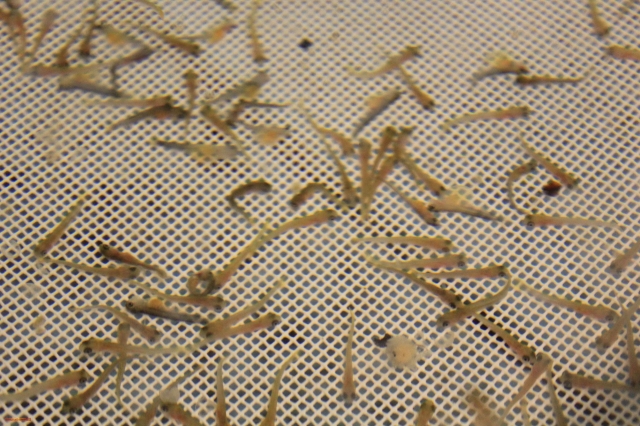






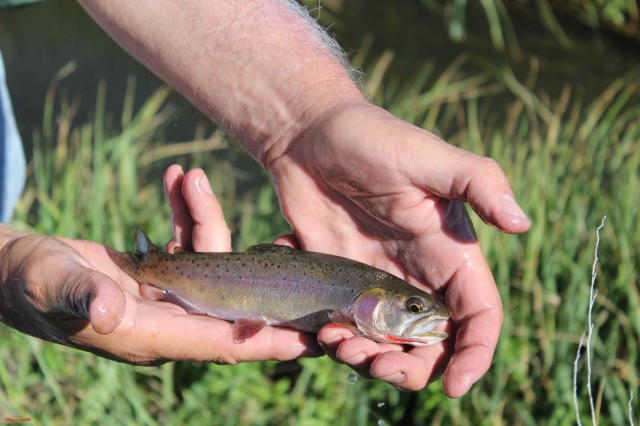


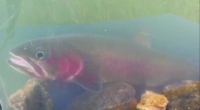








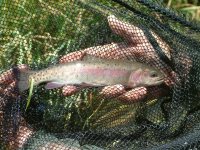

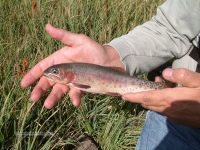


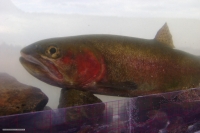




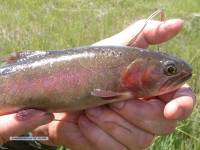




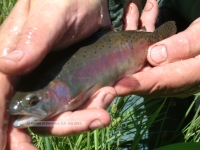

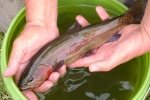









Thanks, Dave. Appreciate the update. I’m living the process through you. – Wayne
What beautiful fish. I am still amazed at their uniqueness. Lahontan cutthroat they are not. Will
get that letter of support sent out. Keep up the good work. I hope their is a service project next
year where we can finally meet.
How are the water levels out there this year?
Hello Patrick. When there in July the creek was already quite low and temps were warm.
We’re just starting to see what may be a cooling trend, and will probably work to get back on the creek again this fall – hopefully a few more times this year.